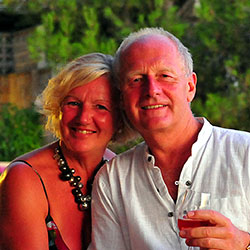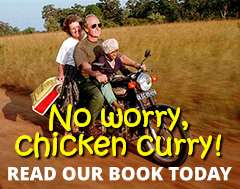Our introduction to Laos gives an insight into a beleaguered people’s assimilation of modern life while trying to retain traditional lifestyles
Our guest writer Helen Tippins sheds some light on this emerging but still little known country.
Although nominally Communist since 1975, as the Lao people’s Democratic Republic, Laos remains a spiritual country with Buddhism influencing all aspects of daily life. Much of the country is a tranquil haven, with red dust roads and water buffalo in the fields, food stalls and other stalls in small settlements selling a mix of household goods, such as tyres, kitchen implements and chairs.

Buddhist monks loading their boat on the Mekong
Dogs lie asleep in the shade and chickens scratch around in the dust. Children play and various herbs are left out to dry. We see men playing petanque – a legacy from the French. The towns are similar but more sprawling, haphazard and also full of markets, small shops and other fascinating sights.
Our introduction is immediate, as amidst the lunacy of tuk-tuks, bicycles, cars and lorries, two women stallholders argue heatedly until one noisily chases the other down the road, adding to the general chaos.
We are here for six days, starting in the capital, Vientiane and then flying to Luang Prabang, which is the former Royal capital.
Vientiane is opening up new trade routes and the airport has increased the number of flights it has. The city attracts mixed reviews. We love it but it is not universally acclaimed, unlike Luang Prabang. There are traffic choked roads and a profusion of neon lights, with some high rise buildings and shopping malls.
French colonial brick buildings are much in evidence but mainly crumbling, although some are now being restored. Tree lined boulevards and coffee shops plus some interesting and acclaimed restaurants add to a semi-cosmopolitan ambiance.
We try Laap, a type of pork salad and the national dish, together with a spicy papaya salad, which is also very popular. Made with minced pork, duck or beef with fish sauce, chillies, shallots, lime juice and fresh herbs it’s an appetizing dish eaten with sticky rice.
It is a laid back capital. Things are done in Laotian time and not rushed, a frustration that takes some assimilating for Europeans at times. It’s not easy to be served food quickly if you’ve a deadline to meet, although there are more European fast foods available; for the most part if you eat Laotian, you eat it in Laotian time!

The Patuxai Victory Monument, Vientiane
As you’d expect, Buddhist temples are in evidence throughout the city and riverside markets plus, largely uncrowded, cultural sites. The Patuxai Victory Monument, a distinctive landmark, is similar in appearance to the Arc de Triomphe but is adorned with images of mythological creatures such as the half-bird, half-woman, Kinnari. Built to commemorate the struggle for independence from France, it features five towers in the Laotian style that represent the five principles of co-existence among nations of the world and the five principles of Buddhism.
Amusingly, It was apparently built with cement donated by the French for the airport.
The huge sprawling Night Market sells clothes, paintings, food and souvenirs – we bought some beautiful handmade cards with Laotian scenes carved into them, which delighted the recipients when we got home. It’s a vibrant market and well worth a visit in the warmth of the evening as the breeze from the river gently distributes the fragrant smells of barbequed meat, stir fry and pans of curry bubbling away, as cooking sounds mingle with the laughter and chatter of thronging tourists mixed with the calls, banter and jokes of happy, smiling stallholders.
Wat Haw Phra Kaew is a Buddhist temple in Vientiane, well-known not only for its striking appearance but because it once housed the Emerald Buddha, now in Bangkok. Pha That Luang Stupa is the most important Buddhist monument in Laos; believed to contain the breastbone of the Buddha. Most notable is the huge golden reclining Buddha within the gardens.

Reclining Buddha, Pha That Luang Stupa
It is surrounded by temples, one of which is Wat That Luaung Neua – the former Royal Temple. There are over 10,000 Buddha images in Wat Si Saket temple which is the oldest temple to retain its original form in the city. We visited on a searingly hot day and although the sites are large they can be covered fairly easily.
The National Museum, in an old colonial French building, houses an eclectic mix of exhibits with the history of Laos from prehistoric times to the present day – in my opinion, well worth a visit if you’re interested in Laotian history.
We visit the Orthopedic and Prosthetic centre, a charity set up to help those with physical disabilities, many from the unexploded landmines that are still contaminating a quarter of Laos’ rural villages, from the Vietnam war. It isn’t for the faint hearted. Laos has a history of cruelty and hardship inflicted on the country, second only to Cambodia and I feel that it’s important to recognise this as the effects are still being felt and it puts a different perspective onto our travels. There are some interesting stories of the hardships and there is much good work being done to help the victims.

Coconut cakes, anyone?
Luang Prabang is a UNESCO world heritage site lying in a green wooded valley nestled into the mountains, which we reach by a short plane journey.
It is an unforgettably pretty town. The streets are lined with wooden French colonial houses, rich temples and a thriving night market selling food, including small delicious coconut cakes, cooked several at a time in special pans while you wait, plus a range of hand woven textiles and silk scarves, cosmetic bags, paintings and other goods all in wonderful bright colours.

Alms ceremony, Luang Prabang
It is well known for the Alms ceremony. We get up at dawn to see the saffron-robed monks collecting rice from kneeling visitors and tourists.
Some of the offerings don’t look very hygienic and we hear that unscrupulous locals sometimes sell stale food to tourists, making the monks ill! However, we find a quiet side street away from the main thrust of tourists and everything proceeds respectfully and calmly with local people taking alms.
It’s fascinating to watch and well worth dragging yourself out of bed to see.
You are expected to cover up if you wish to give alms, as cleavage and other naked flesh is considered disrespectful.
Wat Xieng Thong, known as the ‘Golden Monastery’, is the oldest monastery in the city and arguably the most beautiful. It was built by King Setthatirath around 1560 and has a gracefully sloping roof and glass murals; one of which is the Tree of Life along with other carved walls of Buddhist images that adorn the walls.

Wat XiengThong, Tree of Life

Xieng Thong Temple mural
The national Museum is the former Royal Palace. King Sisavang vat Thana was forced to abdicate in 1975, and with most of his family sent to a jungle camp, where it is believed, they died of starvation. However, we’re informed that the Princess was spared this fate as she had previously been a commoner. She now lives in Luang Prabang.
Surprisingly, in view of the political history, the Museum houses a lot of Royal artefacts, such as photos, thrones and other furniture as well as the Crown jewels and golden and ivory Buddha’s.

National Museum, formerly the Royal-Palace, Luang Prabang
Wat Mai, the largest and most richly decorated of the temples, was once the residence of the head of Laotian Buddhism
Side by side with the underlying poverty and the effects of isolation on the people, by stark contrast there are now many more tourists, smart, air conditioned restaurants and boutique hotels, which in their own way, one would hope, will start to alleviate this imbalance.
One of the more famous sites includes the Pak Ou caves along the Mekong River, which contain hundreds of miniature wooden Buddha’s.
We next visit a farm in the countryside which demonstrates hand weaving. We try our hand at making woven bamboo mats with varying degrees of success. The very patient farmer’s son spends all his time helping out but we’re constantly distracted by spending a lot of time spraying ourselves with mosquito repellent. There’s no shortage of insects dive bombing us as darkness falls.
We enjoy a cookery course at the same farm and after an inauspicious start, as we seem inept at the intricacies of making spring rolls – probably from consuming Lao beer more enthusiastically than learning the earlier weaving methods – but the food is eventually cooked and proves delicious. Although the ubiquitous sticky rice is by now losing its appeal, stuffing bamboo sticks within which to heat it, proves novel.

Sunset over the mighty Mekong River
Laos is a country which should be visited sooner rather than later as the pace of change is incredible. The culture and the people are vibrant and colourful – doing their best to change and adapt to modern demands but conscious and protective of their traditional way of life.
Keep an open mind and I am sure you’ll thoroughly enjoy it.
 Helen Tippins
Helen Tippins
Why go to Laos? The country is little known by comparison with its neighbouring countries of Thailand, Cambodia and Vietnam, who have seen a huge increase in tourism. Even Myanmar now features on many ‘to do’ lists.
I didn’t know much about Laos apart from the legacy of landmines it was left with after the Vietnam War – but the more I thought about it, the more I wanted to see it for myself. Having visited the adjacent countries and being entranced by the scenery, people, history and culture of each, I felt that I must see Laos for myself in order to compare the way of life of a country yet to be completely overrun by commercial interest.
If you’re tempted to write an article for The Luxury Couple about your own experiences then why not contact us here.

Why not ask us to arrange your own tailor-made travel throughout Laos and Southeast Asia?

 Let us plan your own inspiring journey to Laos, Cambodia, Vietnam and throughout Southeast Asia
Let us plan your own inspiring journey to Laos, Cambodia, Vietnam and throughout Southeast Asia
Why not download the TLC World guide brochure or give us a call today on 01202 030443, or simply click ‘enquire’ to submit your own personal itinerary request






















